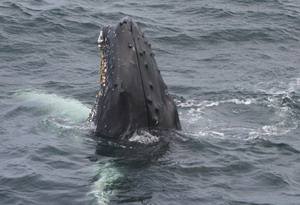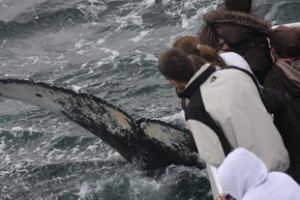Dolphin Fleet Naturalist Notebook 11 October to 16 October
The morning of October 11was bright and clear and we began the day by heading up to the center of Stellwagen Bank to the site of the old BE Buoy, one of several buoys that marks the shipping lane into Boston. As we got closer to the area, we could see the flash of a bright white pectoral flipper – a sure sign that there were humpbacks around! When we arrived, we found both Banyon and Doric. Banyon breached several times, and both of them rolled on their side, raising their long, white pectoral flippers and slapping them down on the surface.
After consulting our on-board humpback whale catalog to confirm the identities of these whales, we noticed something interesting about these individuals’ life histories – they both have the same mother! Glo, a mature female, gave birth to Banyon in 1998. Three years later, in 2001 she gave birth to Doric. While many species of toothed whale are part of long term groups based on family associations, this is not the case for baleen whales such as the humpback. Humpback whales will stay with their mothers for a year, but as far as we know, this is the end of any sort of predictable familial association, which is why we were surprised to see these two whales together. Perhaps it was a coincidence, or perhaps these whales’ dramatic surface behavior was some sort of acknowledgement of their shared lineage.
Our October 12 trip on the Dolphin VIII brought us much farther to the east than we normally go, but it was worth it was we came across a number of feeding humpbacks, many of whom we hadn’t seen in quite some time! A group of six humpbacks, including Seal, Pogo, Putter and Evolution had evidently found a large patch of food through which they swam, mouths wide open, until they could squeeze the salt water between their baleen plates and swallow their prey whole.
These humpback whales will be heading down to their Carribbean breeding grounds in a little over a month and a half. Until then, they must eat as much as they can, as large schools of fish which can adequately feed these whales are sparse in the lower latitude ecosystems that these whales call home during the wintertime. For now, they must concentrate on building up their energy reserves in the form of fatty tissue, or blubber, so that they can successfully mate or birth their calves, and return to the nutrient-rich waters of the North Atlantic next spring.
On October 13, moderate easterly winds kept us closer to home, but we were still able to track down our mainstay group of humpbacks. Canopy and Calf, Whisk and her Calf, and Pele were this time joined by Perseid. Perseid is a female who gave birth to a calf last year. Although Pele is thought to be a male, this humpback is named for a Hawaiian volcano goddess. If you look closely at the pattern on the underside of his fluke, it almost looks like a volcano spewing ash and lava.
We’ve been surprised to see these whales associating with each other in approximately the same area for the past month or so, and today they didn’t disappoint. One humpback could be seen lobtailing, or slapping its tail down, while another flipper-slapped nearby. This seemed to catch the attention of a nearby group of humpbacks, composed of Milkweed, Ravine and her calf. Curious about the nearby ruckus, one of these humpbacks raised its head out of the water to have a look around, engaging in behavior scientists refer to as spyhopping!
October 14’strip on the Dolphin VIII had a wide array of spectacular and diverse sightings from the moment we pulled out of the boatslip. Provincetown Harbor was filled with both mature and immature Northern Gannets. Northern Gannets are seabirds with a particularly notable feeding behavior. They cruise high above the water, often flying in circles. When they spot a fish, they will fold their wings close to their bodies and plummet headfirst into the water with their eyes wide open. When they collide with the sea surface they are sometimes going as fast as 45 miles an hour! Ideally, they will land in such a way that they can grab their food on their way back up to the surface.
Soon after leaving the harbor and rounding Wood End Lighthouse, our captain stopped upon seeing a huge, floppy dorsal fin in the water. For the next 10 minutes, we spent our time in the presence of a huge basking shark! As the second-largest fish on the planet, these 30 foot basking sharks have a pretty intimidating appearance, but they pose no threats to humans. Their small teeth are never used, and instead, they make use of a filter-feeding mechanism similar to baleen in order to eat small crustaceans such as copepods.
It was after leaving Cape Cod Bay that we had our first whale sighting. While Whisk, Canopy and Pele were on a long, deep, dive. Whisk and Canopy’s calves floated at the surface, rolling to their sides and slapping their flippers. Suddenly, Whisk’s calf dove quickly and emerged in a full breach! This apparently attracted attention to the area, as a third mother and calf pair came rushing to the scene, at which point they breached as well! When we headed for home that day, we were satisifed that we had seen some of Cape Cod’s marine wildlife at its best!
On October 15we headed in the same direction, and once again found two basking sharks feeding right near the beach at Wood End Light. Their mouths were wide open and they were swimming in a straight line, filtering planktonic organisms through their gill rakers. Eventually, after heading north, we relocated our group of humpbacks from the previous day. Their long, deep dives and scrape markings along their jaw lines indicated that they were probably feeding on the ocean floor. However, as per usual, the calves were spending much of their time at the surface, occasionally spyhopping to  see what was going on above the water.
see what was going on above the water.
October 16th turned out to be the last day of whale watching for the Dolphin Fleet this season. Although light winds from the southwest made the air feel humid and warm, the gray haziness on the horizon reminded us that fall was here.
We made our way to the eastern edge of Stellwagen Bank where we found our regular group of five humpback whales. Since we first saw them earlier in the season, Canopy and Whisk’s respective calves have grown quite a bit, to the point where, when they are alone at the surface, we can’t immediately tell that they are still under a year old! By the afternoon, this quintet was joined by another group made up of two mom and calf pairs, as well as a fifth “escort” whale. Milkweed stuck by Ravine, Division, and their calves, and for a few minutes, this group of ten humpbacks wowed the passengers aboard the Portuguese Princess II. Watching ten humpback whales surface, breathe, and fluke synchronously is certainly not an everyday occurrence!
We left Stellwagen Bank that day not knowing that the weather in the upcoming days would keep us on shore, but because the Stellwagen Bank National Marine Sanctuary is a favorite spot for hungry humpbacks, as well as other species of whales, we know that we will see many of our favorite individuals again when the season starts again next April.
In the meantime, stay in touch with the marine ecosystem! Here are a few ways to do so:
If you live locally, grab your binoculars! It’s possible to see whales off of Cape Cod at any point during the year. The winter can be a great time to watch for fin whales, as well as North Atlantic right whales, from shore. So bundle up, head to the beach, and scan the horizon to look for spouts!
If you’re land-locked, spend some time learning about our marine environment. From Herman Melville to Rachel Carson to National Geographic to NPR, you don’t have to look too far to find out more about what’s going on in our oceans. To get you started, visit “Our Ocean World” and download their free podcast to get a daily taste of current scientific information about state of the seas and its inhabitants.
Get involved! What can you do to make sure that we are able to visit these whales in healthy environments in years to come? Vote for politicians that support strong environmental policies. Support conservation efforts both locally and globally. Think about both small and large behavioral changes that will reduce your carbon footprint. Here are some websites that will help you get started:
Provincetown Center for Coastal Studies
Whale and Dolphin Conservation Society
Cetacean Society International
There are many more, so do some exploring!
Thanks for a great season and we can’t wait to see you next year. Keep checking for a 2008 Year In Review update on the Naturalist Notebook blog.






